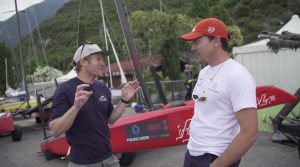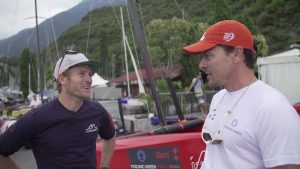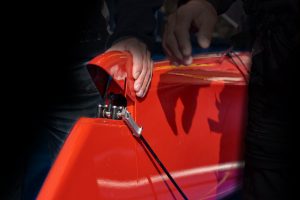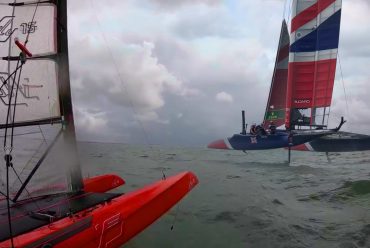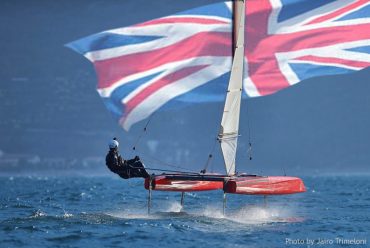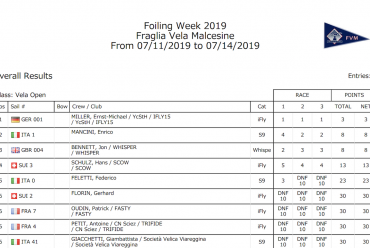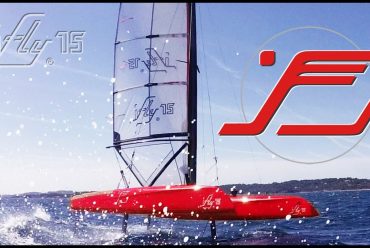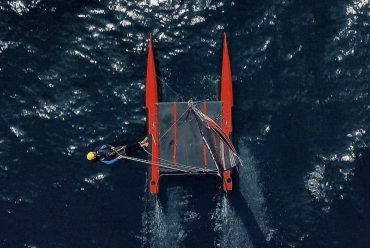François Gabart foiling on iFLY15
François Gabart,
record holder Round the World single handed (42,7 days) and sensational Vendee Globe winner, is one of the best sailors of the world. Gabart is not only rushing enormous Trimarans and IMOCA60 around the world, but he is also sailing on small flying catamarans, lately successfully racing in this years edition of Foiling Week Garda. Gabart and crew Louis VIAT, TEAM MACIF, finished second in category “Flying Phantom”, behind TEAM ELEVEN (Maximeet et Jérémy BACHELIN).
In “All Foilers” race category, the winning boat was iFLY15, the shooting star of single handed flying catamarans. This year, there were six iFLY15 participating at Foiling Week Garda.
François Gabart sailed on iFLY15 between races and talks about his experience: go to french post >>
post download in German >>
« … it was really great. It is a new boat that I didn’t know so far. Very stable, extraordinary stable. It is extremely interesting, because You immediately see the accessibility of the boat. Almost for anyone, who does a little bit of sailing. You just jump on the boat and it is stable flying. It is even flying in light winds. In my opinion a great boat to access flying on the water / foiling. »
(translated from French. Full original interview in French here –>>)
(Full translated interview in English here –>>)
(interview download in German)
— the German aviation engineer – and the sailor —
E-Michael Miller, designer of the iFLY15, sailed the winning boat in the races. The aviation engineer from Germany claims for his serial produced hydrofoil catamaran:
“we love speed, while keeping control”.
He is convinced, that it is not mandatory that high performance flying boats need to be problematic to handle.
“By winning in Garda, iFLY15 has proven to be high-performing – despite flying stable”
he says winkingly. This ironic remark refers to some sailors believing that foiling boat designs with active stability control are supposed to be slow and only for foiling beginners.
“It is a mystery that some sailors seem to see a contradiction between speed and stable flight. The contrary is true, as proven on latest Americas Cup in Bermuda. The winning boat there was the one with the superior flight stability”.
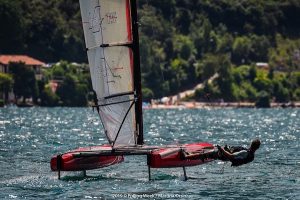 — competition of the designs —
— competition of the designs —
Flying moth class are having an active flight control system in place and for sure the mothies are among the most performing flying boats on this globe. Same applies for the configuration of the foil(s) in T-shape. Despite some considering them as slow for quite some time, this foil configuration is proving his potential in moth class or Vampire project and is now seeing its revival in coming Americas Cup.
— experience from aviation and automotive industry —
Miller is a passionate supporter of mechanical systems supporting stable flight on foiling boats. He makes a comparison with cars, where great performance is unthinkable without optimal road holding enabled by high developed chassis – for most of professional and non-professional drivers also including high-tech like ESP/DSC that keep a powerful car on the road.
“As flying boats are airplanes, even higher quality and safety standard should apply than in automotive or naval industry”,
says the aviation engineer, who is professionally familiar with flight control systems.
— the right level of challenge : handling risk —
Currently there is a discussion ongoing in the sailing world about this question. “Good sailors don’t need mechanical nannies” is a statement that could be lately read in a blog in social media. Somehow it is perceived cool to sail on non-stabilized designs. Many “likes” and “shares” in social media are given for the most spectacular crashes. There are different opinions about how demanding or dangerous a racing boat should be. Miller:
“When flying over the water at speeds up to 30 knots/55km/h, single handed and while standing in the trapeze, You will love every bit of additional stability You can get. Who has really experienced it, will know that it is not funny to realize that You are loosing control over the boat. ”
There are many sailors who have lost interest in foiling as a whole, because they fear loss of control. Even some professional sailors would prefer to sail on a vessel with less problematic handling, to be able to focus on what sailing is about. Racing in a non-foiling performance class, especially if single handed, has always been a full time job. By adding the third dimension without supporting the sailor, it can be an overload. And it can become dangerous, for the sailor as well as for the people around. “We are not gladiators to please the spectator” was one statement picked up lately. Those appalling crashes shared an liked all over might be fun to watch (at least for those who enjoy such horror pictures, while themselves sitting safely in front of the TV/computer), but nobody seriously likes to be in such a situation himself.
“I don’t want to entertain sensationalist onlookers. I go foiling to enjoy high speeds and the sensation of flying. But I prefer to stay safe and sane and be able to go to work on the next day.”
Other opinions go rather in the opposite direction. Paul Larsen, fastest sailor on earth, lately stated in regards to risks of non-stabilized foiling:
“Well, that’s sport. You choose your sport on how you want to be challenged”. There are replies like “Paul Larsen, you are not the only one that enjoys the corner of the hot/crazy matrix mate!”.
It is good that there are different boat designs meeting every individual’s needs.
— High-Tech —
Be that as it may, on iFLY there is an advanced mechanic flight control system in place, actively steering the foils under the water, permanently and without the sailor operating the foils while sailing. To achieve this, the flight height is measured on both bows while sailing. This principle is not new, but successfully used since many years in several flying boat designs. However, it is the details who make the difference between the various designs of flight control systems. Linear vs. algorithmic approach, gearing, position of the wands (altimeters), precise game-free engineering, smallest optimizations e.g. in the hinge area of the flap… are having a huge influence on the flight behaviour and performance. At the end it is the sum of many details and high quality engineering that make a successful little airplane.
— review Foiling Week regatta —
During Foiling Week racing, in up to 20knots of wind, iFLY was showing stable upwind foiling with windward rake (inverted to conventional catamarans heeling). The boat was flying at high speeds and good angles / vmg (speed regards to wind/next mark). On the downwind leg iFLY performed a couple of foiling gybes. The difference in speed was very pronounced, with iFLY15 going deeper and significantly faster than the competing designs, while fully trapezing and the una-rig trimmed as upwind.
— half-professionnels and recreational sailors —
Especially on those downwind legs, Miller made up for quite some tactics and sailing mistakes previously made. Clearly, the second positioned Federico Feletti (Italian champion in a-class (classic) and Teo Di Battista (both on S9) were the more experienced sailors. This became especially visible in low wind conditions of race day3, where tactics and knowledge of Garda wind systems had a great influence on racing results. However, despite semi-professional sailors on the competing boats, during full foiling conditions and especially the strong conditions of race day1 iFLY15’s sheer superior boat speed and good angles made the difference. In race one, Miller was first at the finish line with a big advance of >1minute. In a <30minutes race he made up for an initial lag of >4 minutes that he got from late starting. (However, finally this race was judged DNC, interim race results day1 was 1,1,1.)
— foilers in strong winds —
Race day 1 was ended by a strong wind front, passing the lake from the North. It was interesting to see the iFLYs flying stable at >25knots of wind, heading away lee-wards towards Fraglia Vela Malcesine harbour. Different than during racing, where downwind foiling was performed for maximum vmg, trapezing with sail trim just as upwind, in strong winds applied the safe flying mode: Flying safely while sitting on or behind the rearward crossbeam, traveller open, and actively helming + mainsheet work. If still feeling uncomfortable, or in even stronger winds, iFLY can be switched to “No Fly” mode within seconds. The boat will then not fully take off, but be extremely stable to sail. Earlier this year, this was successfully tested in winds of up to 40knots.
— change of philosophy —
It seems that in the world of foiling, the clear differentiation between racing yachts and recreational sailing blurs. Just as long-established truth as “length runs”. For centuries it has been the basic rule of fluid sciences explaining a fast boat. However, when flying the hulls through the air, new characteristics count. iFLY15 is only 15ft./4.63m short, while having many qualities from a 18 footer. Width is 2.50m, providing plenty of righting moment, and buoyancy is enormous, to be forgiving when landing the craft…
— aiplanes —
The avionic engineer Miller claims: “Foiling boats need to be born to fly. Any refitting of old designs or even class rules will never produce the perfect foiler. There are more differences between a flying boat and a conventional vessel than the eye can meet.“
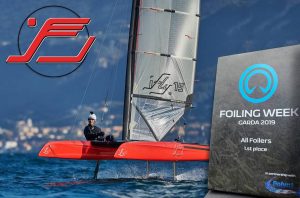
Regatta results:
http://fragliavela.sailti.com/en/default/races/race-resultsall/text/foiling-week-2019-en


